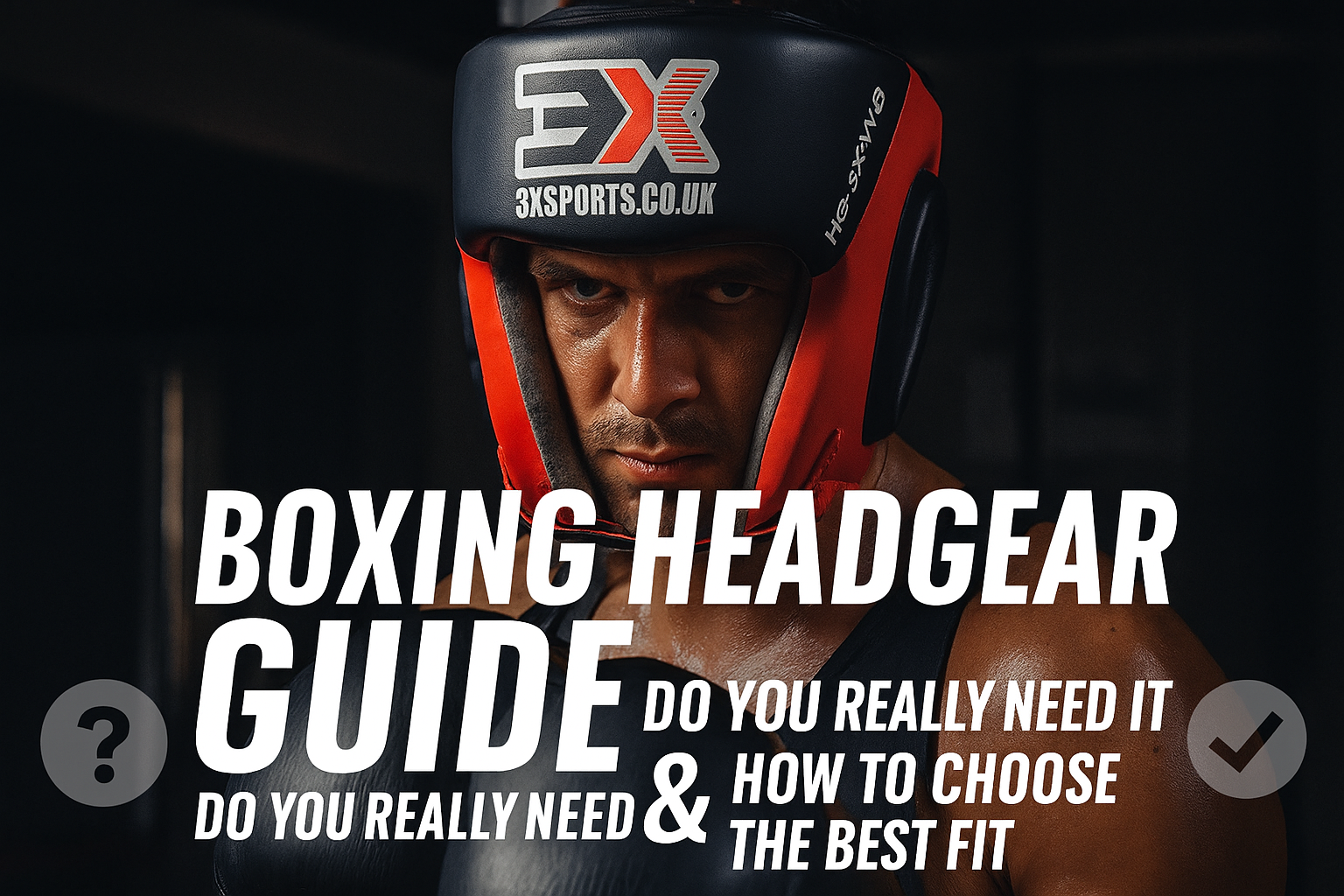Whether you’re a beginner stepping into your first sparring session or a seasoned amateur fighter, boxing headgear is a hotly debated piece of equipment. Some argue it’s essential for safety; others claim it adds bulk without benefit. So what’s the truth? In this comprehensive guide, we’ll break down everything you need to know about boxing headgear—when it’s needed, what it actually protects, the benefits, and how to choose the right one. Plus, we’ll showcase 3X Sports’ top picks to help you gear up with confidence.
Introduction – Why Headgear Is a Hot Topic in Boxing
Boxing is one of the most physically demanding combat sports out there. While gloves and mouthguards are universally accepted, headgear sparks a lot of discussion. Why? Because there’s a misconception about what it actually does.
On one side, you have boxers who swear by it—claiming it helps reduce facial injuries and gives confidence in the ring. On the other side, some believe it gives a false sense of security and doesn’t prevent serious trauma.
The truth lies somewhere in the middle. Headgear isn’t a magic shield—but when used correctly and in the right context, it can make a big difference. For beginners, understanding why, when, and how to use headgear is crucial for safe and effective training.
Do You Really Need It? – When Headgear Is Necessary
So, do you need headgear for boxing? The short answer: yes, in specific situations.
When You MUST Wear Headgear:
- Sparring: Whether you’re a beginner or advanced, sparring sessions should always include headgear. It reduces superficial injuries and makes training safer.
- Amateur Fights: Most amateur boxing leagues require headgear—especially for youth and novice divisions.
- Drills With Contact: Partner drills that involve controlled strikes benefit from protective gear, including headgear.
- Gym Requirements: Some boxing gyms mandate headgear for safety and insurance compliance.
When You Can Skip It:
- Bag work
- Shadowboxing
- Conditioning drills
For non-contact training, headgear isn’t needed. But once you introduce contact—even light—it’s smart to strap up.
Myths vs Facts – What Headgear Actually Does and Doesn’t Protect
Myth 1: Headgear prevents concussions.
Fact: No, it doesn’t. Headgear is not designed to absorb enough impact to prevent brain trauma. Concussions are caused by the brain shaking inside the skull, and no foam padding can stop that completely.
Myth 2: Headgear makes you invincible.
Fact: Not even close. You can still get rocked, stunned, or injured wearing headgear. It’s a tool—not a shield.
Myth 3: Headgear limits vision.
Fact: Poorly designed or ill-fitting headgear can limit vision. But high-quality headgear from reputable brands (like 3X Sports) offers excellent peripheral vision without compromising safety.
What Headgear Actually Does:
- Reduces facial injuries like cuts, bruises, and broken noses
- Protects the skin from glove friction
- Minimizes head clashes (especially during inside fighting)
- Boosts confidence in sparring, especially for beginners
Benefits of Wearing Boxing Headgear
Still not convinced? Here’s what wearing headgear can actually do for your performance and protection.
1. Reduces Cuts and Bruises
Repeated jabs, hooks, and clinches can leave your face looking like a punching bag. Headgear provides padding around vulnerable areas like the cheekbones, forehead, and chin—helping prevent those ugly post-session bruises.
2. Encourages Sparring Confidence
Many beginners hesitate during sparring. Headgear acts as a psychological safety net, helping you build confidence to trade punches, move forward, and develop real ring experience.
3. Enhances Focus
When you’re not worried about getting cut, you’re able to focus more on technique and defense—rather than just surviving the round.
4. Safer for Your Partner
Let’s not forget: headgear also helps protect your sparring partner. Padding reduces the risk of accidental clashes, elbow scrapes, or forehead shots that lead to cuts.
How to Choose the Right Boxing Headguards – Fit, Material, Brand
1. Fit is Everything
Your headgear should be snug but not suffocating. A loose fit means shifting during movement, which can block your vision. Too tight, and it becomes uncomfortable and distracts you during sparring.
- Measure your head circumference and follow brand sizing charts.
- Look for adjustable straps and chin fasteners for customization.
2. Material Quality
Avoid cheap foam and synthetic leather. Choose multi-layered foam and premium synthetic and real leather for durability, breathability, and protection.
- Inner lining should wick sweat and stay odor-resistant.
- Outer shell should withstand glove impact without deforming.
3. Vision and Coverage
Pick a design that offers open-face vision with strategic padding. Avoid overly bulky designs that impair visibility—especially if you’re learning footwork and defense.
4. Certification
If you’re competing, check for USA Boxing or AIBA-approved headgear. They meet safety standards required for sanctioned events.
3X Sports Picks – Best Boxing Headgear for Beginners
Looking for the best beginner boxing helmet? 3X Sports has you covered.
✅ 3X Sports Pro Training Headgear
- Best For: General sparring and drills
- Features: Shock-absorbing padding, chin strap, and ear protection
- Fit: Secure Velcro closure with adjustable top straps
- Material: Premium engineered leather for long-lasting use
✅ 3X Sports Full-Face Sparring Headgear
- Best For: Heavy sparring or beginners who want full coverage
- Features: Padded cheek and chin bars, ear padding, wide vision field
- Fit: Ergonomic design with a custom grip
- Bonus: Sweat-wicking inner lining keeps you dry
Why Choose 3X Sports?
- Durable materials
- Affordable pricing
- Designed by combat athletes for real training environments
- Trusted by boxers, MMA fighters, and kickboxers globally
FAQs – Boxing Headgear
1. Does boxing headgear prevent concussions?
No, headgear does not prevent concussions. It helps reduce facial injuries but cannot stop internal brain movement caused by impact.
2. How tight should boxing head guards be?
It should be snug enough to stay in place during movement, but not so tight that it causes headaches or restricts breathing.
3. Can I use headguards boxing for MMA sparring too?
Yes, many headgear models, including those from 3X Sports, are suitable for MMA and kickboxing sparring as well.
4. How do I clean my kickboxing head guard?
Wipe it down with a damp cloth after each session. For deeper cleaning, use anti-bacterial spray or a mild soap solution. Always air dry.
5. How long does boxing head guard full face last?
With proper care, good-quality headgear can last 12–24 months of regular training. Replace it if padding compresses or if it starts shifting during use.
Conclusion – Protect Your Head, Elevate Your Game
Boxing headgear may not prevent every injury, but it’s a vital tool for safer sparring and smarter training—especially for beginners. It boosts your confidence, reduces facial injuries, and allows you to focus on your technique without fear. Choosing the right headgear, like the trusted options from 3X Sports, ensures you’re not only protected but performing at your best.
🎯 Ready to gear up?
Check out our full collection of boxing headgear and protective gear at 3X Sports and start your training the smart way.

